How to repair PVC inflatable paddle boards and iSUPs
This guide is for:
- Repairing inflatable stand up paddleboards (iSUPs)
PVC / PU Inflatable Repair Guide
This guide is for repairing inflatables that are made with PVC and Polyurethane only.
Safety first
Adhesives and solvents produce fumes which can be damaging to your health when inhaled, absorbed through the skin/eyes or ingested. The fumes are also highly flammable. Always read the product labels carefully before starting the repair job.
The work area
Successful repairs to inflatable paddleboards are dependent upon the environment in which the repair is carried out - ideal conditions are:
- relative humidity less than 60% (low cost humidity meters can be obtained from most good DIY stores if unsure)
- temperature between 18°C and 25°C
- dry, shaded but well-ventilated work area
- no naked flames or uncovered heat sources in the vicinity
Identify the fabric type
Before contemplating your iSUP repair and buying adhesive or a repair kit, you will need to identify the fabric that your board is made from. The type of fabric determines the type of adhesive, solvent and patch fabric that is required to undertake the repair. Almost all iSUPs are PVC or PU, but refer to the paperwork that came with your board or manufacturer’s guidelines if you’re unsure.
Materials & tools required to complete this job
- 2-pack Adhesive, such as Inflatex’s 2-pack Adhesive for PVC & PU fabrics
- Correct fabric patch
- Solvent/primer e.g. MEK or acetone
- Mixing stick e.g. lollipop stick
- Clean, lint-free cloth
- Short/stiff paint or glue brush
- Removable marker pen or pencil
- Masking tape
- Seam roller or rounded object e.g. smooth screwdriver handle
- Optional: Heavy weight (to hold patch in-place whilst curing)

Materials & Tools
Get to work repairing the leaking board
Locate the tear or hole on the board. If unsure as to where the puncture is located, e.g. you have a ‘slow puncture’, then apply soapy water to the inflatable and observe any bubbles forming at the puncture site. Mark the location, dry the area and deflate the board. At TubRepairs, we prefer to use a big wide paint brush for this, but a household spray bottle or sponge can work too.
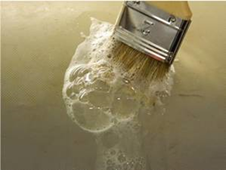
Bubbles identifying leak.
PVC repairs can be divided into small tears or punctures and larger tears (over 50mm long). Small tears/punctures can be easily repaired with a single patch to the outside, but larger tears are difficult due to the ‘drop stitch’ construction of paddle boards making internal patches impossible due to the threads.
Cut a fabric patch with rounded corners, allowing a minimum 5cm overlap around the hole/tear. Place the patch over the hole and mark around the patch on the board with a pencil/removable marker.

Outline of patch being marked on the board.
There is no need to abrade PVC fabric, but you will need to clean up / remove old glue or sealant from failed repairs. This is where sand paper is handy.
Clean/prime the back of the patch and the repair area, using a clean dry lint-free cloth, by wiping with MEK solvent or acetone. Wait until the solvent has evaporated. (N.B. it is normal for the area to become 'tacky').
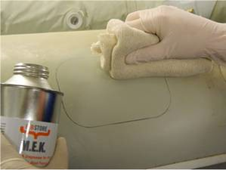
Clean and prime the repair area prior to applying the adhesive.
Mask around the repair area on the board with removable masking tape to prevent unsightly adhesive ‘overspill’ when applying the adhesive. Allow a 2-3mm gap around the pencil/removable marker line to allow for some stretch in the patch when applied.
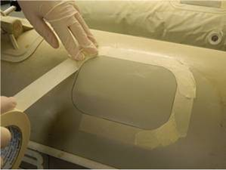
The repair area on board being masked-up.
Mix the adhesive with a mixing stick, as per the instructions supplied with the adhesive.
Using a brush applicator apply an even thin coat of adhesive to both the back of the external board patch and the masked repair area. Leave to dry for at least 20 minutes. Apply a second coat of glue and remove the masking tape immediately. Leave the glue to dry for 2 minutes or until tacky.
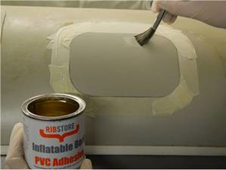
Applying the 2-part mixed adhesive to the masked and primed repair area.
Using a brush applicator apply an even thin coat of adhesive to both the back of the external patch and the masked repair area. Leave to dry for at least 20 minutes. Apply a second coat leaving it to dry for 2 minutes or until tacky. Apply the patch carefully to the repair area.

Applying the 2-part mixed adhesive to the back of the repair patch.
Apply the patch carefully to the repair area. It is important to position the patch correctly as it is difficult to re-position once in place.
Smooth down the patch firmly using a seam roller or rounded object (e.g. piece of shaped hardwood or screwdriver handle), working from the centre of the patch outwards, in order to remove air bubbles and ensure good contact.
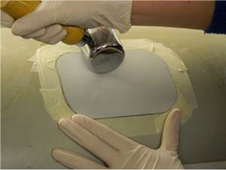
Smoothing the patch with a seam roller to expel air bubbles and ensure a good bond.
If the patch is not sticking in places or air bubbles remain then the area can be gently heated with a hot-air gun or hair drier and ‘re- worked’ [Warning: do not use a hot-air gun or hair drier with adhesives or solvents still in the work area]
Clean-off any excess adhesive with the MEK solvent. It is important to remove any excess adhesive as if this remains on the surface of your paddle board it will turn an unsightly brown!

Cleaning all excess glue from the repaired area.
Allow your repair to 'cure' for 24 hours before re- inflating the board to check that the repair has been successful and before re-launching the board. Optional: Place a smooth sided heavy weight on the patch whilst the glue cures.
Repair Kits to repair your inflatable stand up paddle board can be found HERE.
Did you know that our glues have been tested and approved by leading paddle board manufacturer Red Paddle Co?
